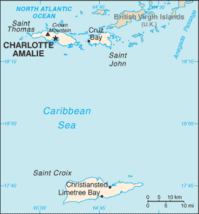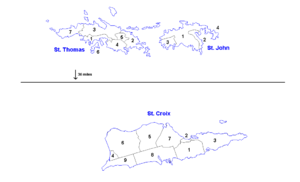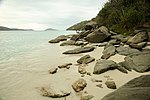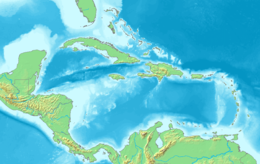Saint Thomas, U.S. Virgin Islands
 Charlotte Amalie, St. Thomas | |
 St. Thomas | |
| Geography | |
|---|---|
| Location | Caribbean Sea |
| Coordinates | 18°20′N 64°55′W / 18.333°N 64.917°WCoordinates: 18°20′N 64°55′W / 18.333°N 64.917°W |
| Archipelago | Virgin Islands, Leeward Islands |
| Area | 32 sq mi (83 km2) |
| Highest elevation | 1,555 ft (474 m) |
| Highest point | Crown Mountain[1] |
| Administration | |
| Insular area | |
| Largest settlement | Charlotte Amalie (pop. 18,481) |
| Demographics | |
| Demonym | Saint Thomian |
| Population | 51,634 (2010) |
| Pop. density | 638.17/km2 (1652.85/sq mi) |

Saint Thomas (Danish: Sankt Thomas) is one of the Virgin Islands in the Caribbean Sea which, together with Saint John, Water Island, Hassel Island, and Saint Croix, form a county-equivalent and constituent district of the United States Virgin Islands (USVI), an unincorporated territory of the United States. The territorial capital and port of Charlotte Amalie is located on the island. As of the 2010 census, the population of Saint Thomas was 51,634,[2] about 48.5% of the US Virgin Islands total. The district has a land area of 32 square miles (83 km2).[3]
History[]
Pre-colonial history[]
The island was originally settled around 1500 BC by the Ciboney people. They were later replaced by the Arawaks and then the Caribs. Christopher Columbus sighted the island in 1493 on his second voyage to the New World.[citation needed]
Danish and German colonial period[]
The Dutch West India Company established a post on Saint Thomas in 1657.[4] The first congregation was the St. Thomas Reformed Church, which was established in 1660 and was associated with the Dutch Reformed Church.[citation needed]
Denmark-Norway's first attempt to settle the island in 1665 failed. However, the Danes did resettle St. Thomas in 1671, under the sponsorship of the Glueckstadt Co., later the Danish West India Company.[5] The first slave ships arrived in 1673, and St. Thomas became a slave market. In 1685, the Danish leased part of the island to the Brandenburger Company,[4] which was resold to the Danish in 1754,[5] and was granted free port status in 1764.[6]
The land was divided into plantations and sugarcane production became the primary economic activity. As a result, the economies of Saint Thomas and the neighboring islands of Saint John and Saint Croix became highly dependent on slave labor and the slave trade. In 1685, the Brandenburgisch-Africanische Compagnie took control of the slave trade on Saint Thomas, and for some time the largest slave auctions in the world were held there.
Saint Thomas's fine natural harbor became known as "Taphus" for the drinking establishments located nearby. ("Tap Hus" translates as "rum shop" or "tap house" referring to the drinking establishments.[7]) In 1691, the primary settlement there was renamed Charlotte Amalie in honor of the wife of Denmark's King Christian V. It was later declared a free port by Frederick V. In December 1732, the first two of many Moravian Brethren missionaries came from Herrnhut Saxony in present-day Germany to minister to them. Distrusted at first by the white masters, they lived among the slaves and soon won their confidence.[8]

The first British invasion and occupation of the island occurred in 1801. The islands were returned to Denmark in 1802, under the terms of the Treaty of Amiens. Fire destroyed hundreds of homes in Charlotte Amalie in 1804. The second British occupation of the island occurred from 1807 to 1815, after the Invasion of the Danish West Indies (1807), during which they built Fort Cowell on Hassel Island.[6]
While the sugar trade had brought prosperity to the island's free citizens, by the early 19th century Saint Thomas was in decline. The continued export of sugar was threatened by hurricanes, drought, and American competition. Following the Danish Revolution of 1848, slavery was abolished and the resulting rise in labor costs further weakened the position of Saint Thomas's sugar producers.[citation needed]
Given its harbors and fortifications, Saint Thomas still retained a strategic importance, and thus, in the 1860s, during the American Civil War and its aftermath, the United States government considered buying the island and its neighbors from Denmark for $7.5 million. However, the proponents of the purchase failed to gain legislative support for the bid.[citation needed]
Freedom of the press[]
As the islands were poorly managed by the Danes[citation needed], a local islander, David Hamilton Jackson, was instrumental in persuading the Danish to allow the US to purchase the islands of Saint Thomas, Saint John, and Saint Croix. In 1915, he traveled to Denmark and convinced the King of Denmark to allow freedom of the press in the islands.[9] He began the first newspaper in the islands, known as The Herald. After this, he organized labor unions among the islanders for better working conditions. The islands now have an annual celebration in November to honor the legacy of David Hamilton Jackson.[10]
United States acquisition[]

In 1917, Saint Thomas was purchased (along with the rest of the Virgin Islands) by the United States for $25 million in gold ($505 million today),[11] as part of a defensive strategy to maintain control over the Caribbean and the Panama Canal during the First World War. The transfer occurred on March 31, 1917, behind Fort Christian before the barracks that now house the Legislature of the U.S Virgin Islands. The baccalaureate service for the transfer was held at the St. Thomas Reformed Church as it was identified as the American church in the Danish West Indies.
At the time of the US purchase in 1917, the colony did not include Water Island, which had been sold by Denmark to the East Asiatic Company, a private shipping company, in 1905. The company eventually sold the island to the United States in 1944, during the German occupation of Denmark. The federal government then used the island for military purposes until 1950, before finally transferring it to the territorial government in 1996.[12]
The United States granted citizenship to the residents in 1927. The U.S. Department of the Interior took over administrative duties in 1931. American forces were based on the island during the Second World War. In 1954, passage of the U.S. Virgin Islands Organic Act officially granted territorial status to the three islands, and allowed for the formation of a local senate with politics dominated by the American Republican and Democratic parties. Full home rule was achieved in 1970.
The post-war era also saw the rise of tourism on the island. With relatively cheap air travel and the American embargo on Cuba, the numbers of visitors greatly increased. Despite natural disasters such as Hurricane Hugo (1989), Hurricanes Luis and Marilyn (1995), and Hurricanes Irma and Maria (2017) the island's infrastructure continues to improve as the flow of visitors continues. Hotels have been built from the West End to the East End.
Geography[]
The island has a number of natural bays and harbors including Magens Bay, Great Bay, Jersey Bay, Long Bay, Fortuna Bay, and Hendrik Bay. Passenger ships dock and anchor in Long Bay, near Charlotte Amalie. Ships dock at Havensight Pier. Red Hook is an unofficial "town" located on the East End subdistrict.
Climate[]
| hideClimate data for Saint Thomas, United States Virgin Islands | |||||||||||||
|---|---|---|---|---|---|---|---|---|---|---|---|---|---|
| Month | Jan | Feb | Mar | Apr | May | Jun | Jul | Aug | Sep | Oct | Nov | Dec | Year |
| Record high °F (°C) | 93 (34) |
93 (34) |
94 (34) |
96 (36) |
97 (36) |
99 (37) |
98 (37) |
99 (37) |
98 (37) |
97 (36) |
95 (35) |
92 (33) |
99 (37) |
| Average high °F (°C) | 85.1 (29.5) |
85.1 (29.5) |
85.7 (29.8) |
86.7 (30.4) |
87.6 (30.9) |
89.1 (31.7) |
89.9 (32.2) |
90.2 (32.3) |
90.0 (32.2) |
88.7 (31.5) |
87.1 (30.6) |
85.6 (29.8) |
87.6 (30.9) |
| Average low °F (°C) | 72.4 (22.4) |
72.3 (22.4) |
72.9 (22.7) |
74.1 (23.4) |
76.2 (24.6) |
77.7 (25.4) |
78.0 (25.6) |
78.1 (25.6) |
78.0 (25.6) |
76.9 (24.9) |
75.2 (24.0) |
73.7 (23.2) |
75.5 (24.2) |
| Record low °F (°C) | 63 (17) |
62 (17) |
56 (13) |
58 (14) |
66 (19) |
67 (19) |
57 (14) |
59 (15) |
64 (18) |
66 (19) |
52 (11) |
62 (17) |
52 (11) |
| Average precipitation inches (mm) | 2.16 (55) |
1.47 (37) |
1.05 (27) |
2.62 (67) |
3.05 (77) |
2.62 (67) |
2.82 (72) |
3.51 (89) |
4.82 (122) |
5.94 (151) |
6.00 (152) |
2.88 (73) |
38.95 (989) |
| Average precipitation days (≥ 0.01 in) | 14.3 | 11.8 | 8.1 | 10.7 | 11.9 | 11.1 | 14.8 | 14.2 | 14.6 | 17.7 | 17.8 | 16.7 | 163.6 |
| Source 1: NOAA (normals 1981−2010)[13] | |||||||||||||
| Source 2: Weather Channel[14] | |||||||||||||
Demographics[]
Saint Thomas is divided into the following subdistricts (with population as per the 2010 U.S. Census):
- Charlotte Amalie (pop. 18,482) Charlotte Amalie town (pop. 10,355)
- East End (pop. 8,403)
- Northside (pop. 10,048)
- Southside (pop. 5,412)
- Tutu (pop. 6,867)
- Water Island (pop. 183)
- West End (pop. 2,241)
Historical ethnic communities[]
From 1796 a small Jewish community developed in Charlotte Amalie. It established the Beracha Veshalom Vegmiluth Hasidim, the second oldest synagogue in the United States.[15]
During the late nineteenth and early twentieth centuries a group of French Catholic immigrants known as the Chacas came to St. Thomas from the St. Barthélemy islands to the east, forming one community of fishermen and one of farmers.[16][17]
Transportation[]

The island is serviced by the Cyril E. King International Airport.
Passenger and limited car-ferry services to neighboring islands such as Water Island, Saint John, Saint Croix, and the British Virgin Islands run regularly out of the Red Hook Terminal, Charlotte Amalie, and Crown Bay Marina.
The United States Virgin Islands is the only place under United States jurisdiction where the rule of the road is to drive on the left. This was inherited from what was the then-current Danish practice at the time of the American acquisition in 1917. However, because the islands are a U.S. territory, most cars are imported from the mainland United States and therefore the steering column is located on the left side of the vehicle.
The island has many regular taxis from compact size to large vans, as well as open-air, covered trucks called "safaris" with bench seats. The latter usually operate only between high-traffic points, e.g., cruise-ship terminals at Havensight and Crown Bay and downtown Charlotte Amalie.
Education[]
St. Thomas-St. John School District operates public schools on Saint Thomas.
Private schools:
- Antilles School
- Virgin Islands Montessori School & Peter Gruber International Academy
Parochial schools:
- All Saints Cathedral School
- Sts. Peter & Paul Catholic School
- Calvary Christian Academy
- Church of God Academy
- Memorial Moravian School
- Seventh Day Adventist School
- Weslyan Academy Bible School
Colleges and universities:
Notable people[]
- Alton Augustus Adams − first African-American band master for the United States Navy
- Jabari Blash - Baseball player, outfielder for the Tohoku Rakuten Golden Eagles
- Edward Wilmot Blyden − ambassador, an Igbo in Diaspora; credited in some history books as having laid the foundation of West African nationalism and Pan-Africanism
- Callix Crabbe − Major League Baseball player
- Midre Cummings − Major League Baseball player
- Vanessa Daou − singer-songwriter, dancer, writer, poet
- Charles Joseph Sainte-Claire Deville − French geologist
- Henri Étienne Sainte-Claire Deville − French chemist
- Gabriel Milan - Governor from 7 May 1684 to 27 February 1686
- Jeff Faulkner − National Football League player
- Kelsey Grammer − actor, director, and producer born in Saint Thomas
- Emile Griffith − former boxer who won world championships in both the Welterweight and Middleweight divisions.
- Elrod Hendricks − Major League Baseball player
- Abdul Hodge − National Football League player
- Daryl Homer − Olympic fencer
- Roy Innis − civil rights leader
- Julian Jackson − boxer born in Saint Thomas
- Hannah Jeter - Sports Illustrated Swimsuit cover model and wife of Derek Jeter of the New York Yankees
- J. Raymond Jones − political activist
- Christine Jowers − choreographer, producer, and dance critic
- Al McBean − Major League Baseball player
- Akeel Morris (born 1992) - baseball player in the San Francisco Giants organization
- Ralph Moses Paiewonsky − governor
- John Patrick − American screenwriter and Tony Award & Pulitzer Prize-winning playwright
- Calvin Pickering − Major League Baseball player
- Camille Pissarro − key member of the French Impressionist group of painters
- Rashawn Ross − trumpeter who tours with Dave Matthews Band
- Roy Lester Schneider − governor and physician
- Karrine Steffans − former hip-hop music video performer and actress and the author of Confessions of A Video Vixen.
- Morris Simmonds − German physician, pathologist, described a syndrome of pituitary failure with emaciation (Simmonds syndrome)
- Edward Teach − pirate and privateer; may have been given a letter of marque from St. Thomas after being pardoned for pirating
- Terence Todman − ambassador
- Jean Toussaint - jazz tenor and soprano saxophonist
- Peter von Scholten − governor general
- Denmark Vesey − leader of planned slave uprising in Charleston, South Carolina
- Tiphanie Yanique – award-winning writer
- David Levy Yulee − American politician and the first member of the United States Senate to have been, at one time, a practicing Jew.
In popular culture[]
Music[]
St. Thomas is among the most recognisable instrumentals in the repertoire of American jazz tenor saxophonist Sonny Rollins based on a traditional calypso sung to him by his mother, Valborg Solomon Rollins, who was born on Saint Thomas.[18]
Film[]
Films, cinema and TV episodes set, or set partly, in locations on Saint Thomas:
- Native Women Coaling a Ship at St. Thomas, 1903, short documentary.
- West Indian Girls in Native Dance, 1903, documentary.
- Five St. Thomas belles dancing their native dance the "She-She" . Short taken on a midwinter cruise of the S.S. "Prinzessin Victoria Luise" of the Hamburg-American Line.
- Wharf Scene and Natives Swimming at St. Thomas, D.W.I, 1903, short documentary.
- Going Places with Graham McNamee, #69 1939, 9 min documentary.
- The Frogmen, 1951, 96 min, war drama, directed by Lloyd Bacon, starring Richard Widmark, Dana Andrews, Gary Merrill, Jeffrey Hunter
- Windjammer: The Voyage of the Christian Radich, 1958, 142 min. romance, directors: Bill Colleran, Louis De Rochemont III, starring: Bjørn Amvik, Arne Andersen, Per Antonsen, Niels Arntsen
- Violent City, 1970, 100 min, crime thriller. Director: Sergio Sollima. Starring: Charles Bronson, Telly Savalas, Jill Ireland, Umberto Orsini
- Girls Are for Loving, 1973, 95 min, crime drama, director: Don Schain, starring: Cheri Caffaro, Timothy Brown, Sheila Leighton, Scott Ellsworth
- Charlie's Angels episode: Love Boat Angels (1979), 100 min, action adventure, director: Allen Baron, starring: Jaclyn Smith, Cheryl Ladd, David Doyle, Shelley Hack
- Supertanker, 1980, action adventure, director: Herbert Wright
- Skateboard Madness, 1980, 92 min, sport comedy, director: Julian Pena, starring: Huck Andress, Gregg Ayres, Ray Ban, Bill Dale
- Gavilan, 1982–1983, 60 min adventure, starring: Robert Urich, Patrick Macnee, Kate Reid, Tadashi Yamashita
- Gavilan episode: Pirates, 1982, adventure, director: Cliff Bole, starring: Robert Urich, Patrick Macnee, Kate Reid, Michael Billington
- Gavilan episode: Sarah and the Buzz, 1982, 60 min adventure, director: Charlie Picerni, starring: Robert Urich, Patrick Macnee, Kate Reid, Earl Boen
- American Ninja 2: The Confrontation, 1987, 90 min action, director: Sam Firstenberg, starring: Michael Dudikoff, Steve James
- The Bold and the Beautiful, 1987, 30 min, romance, starring: Katherine Kelly Lang, Ronn Moss, Susan Flannery, John McCook
- Caged in Paradiso, 1990, 90 min, action drama, director: Mike Snyder, starring: Irene Cara, Peter Kowanko, Paula Bond, Joseph Culp
- A Woman Named Jackie, 1991, 246 min bio-drama, starring: Marianna Bishop, Ann Buckles, Andy Buckley, Stephen Collins
- 1492, 1992, 154 min, bio-drama, director: Ridley Scott, starring: Gérard Depardieu, Armand Assante, Sigourney Weaver, Loren Dean
- Christopher Columbus: The Discovery (1992), 120 min, bio-drama adventure, director: John Glen, starring: Marlon Brando, Tom Selleck, Georges Corraface, Rachel Ward
- Weekend at Bernie's II, 1993, 97 min, comedy, director: Robert Klane, starring: Andrew McCarthy, Jonathan Silverman, Terry Kiser, Troy Byer
- Jay-Z - In My Lifetime, 1995, 4 min, music video, director: Abdul Malik Abbott, starring: Kareem Biggs Burke, Jonathan Burks, Damon Dash, Jay-Z
- Soul Music Festival: Part 5, 1999, 57 min TV Special, director: Chuck Vinson, starring: Roy Ayers, Jon B., Eric Benét, DeBarge
- Open Water, 2003, 79 min, horror, director: Chris Kentis, starring: Blanchard Ryan, Daniel Travis, Saul Stein, Michael E. Williamson
- Trace Evidence: The Case Files of Dr. Henry Lee, 2004, starring: Henry Lee, Tim Palmbach, Andrea Altieri, Peter Brazelle
- Before, During and 'After the Sunset’, 2005, 70 min comedy documentary, director: Kevin Krakower, starring: Kent Alterman, Obba Babatundé, Fonzworth Bentley, Joe Biggins
- A Royal Birthday, 2006, comedy, starring: Q, Nickie Jackson, Kalisha West, Gigi Bell
- Cruising the Caribbean with Olivia, 2007 44 min TV Special, director: Rick Scott, star: Elvira Kurt
- The Curious Case of Benjamin Button, 2008, 166 min, fantasy, director: David Fincher, starring: Brad Pitt, Cate Blanchett, Tilda Swinton, Julia Ormond
- Debajo De La Alfombra, 2010, 8 min thriller, director: John W. Bosher, starring: Rick Vargas, Gustavo Mellado
- My Virgin Islands Carnival, 2010, director: John P. Wheatley, star: George Silcott II
- The Twilight Saga: Breaking Dawn - Part 1, 2011, 117 min, action drama, director: Bill Condon, starring: Kristen Stewart, Robert Pattinson, Taylor Lautner, Gil Birmingham
- Building the Highway to Mars, 2011, 41 min, documentary, director: Ray Arzate
- Caribbean Vibes with Chef Gavin Kearney, 2011, TV Movie, director: Christopher Clarke, star: Gavin Kearney
- The Real World: St. Thomas, 2012, MTV Reality Show
- The Amazing Race 25 episode: Go Big or Go Home, 2014, 44 min, action adventure, director: Bertram van Munster, starring: Phil Keoghan, Adam Dirks, Bethany Hamilton, Amy DeJong
- The Amazing Race 25 episode: When You Gotta Go, You Gotta Go, 2014, 44 min action adventure, director: Bertram van Munster, starring: Phil Keoghan, Adam Dirks, Bethany Hamilton, Amy DeJong
- Damaged Goods (II), 2015, director: Benny Demus, starring: Adiz Benson, Benny Demus, Brittany S. Hall, Shamea Morton
- Is Genesis History, 2017, 100 min documentary, director: Thomas Purifoy, starring: Del Tackett, Kevin L. Anderson, Steve A. Austin, Steven W. Boyd
- The Bachelor episode #21.6, 2017, 84 min, reality-TV, starring: Chris Harrison, Nick Viall, Danielle Lombard, Raven Gates
- The Bachelor episode #21.7, 2017, 84 min reality-TV, starring: Chris Harrison, Nick Viall, Rachel Lindsay, Raven Gates
Points of interest[]
- Blackbeard's Castle
- Buck Island National Wildlife Refuge
- Cathedral Church of All Saints
- Fort Christian
- Magens Bay Arboretum
- Magens Bay
- Red Hook
- Saints Peter and Paul Cathedral
- St. Thomas Synagogue
- Coral World Ocean Park
Gallery[]
Blackbeard's Castle in Charlotte Amalie.

Magens Bay as seen from Drake's Seat, St. Thomas, USVI.

View From Bluebeard's Castle, St Thomas US Virgin Islands

Magens Bay
References[]
- ^ "Where is the U.S. Virgin Islands: Geography". vinow.com. Retrieved April 8, 2017.
- ^ Kossler, Bill (August 24, 2011). "USVI Population Down Since 2000". stthomassource.com. V.I. Source Publications. Retrieved January 11, 2017.
- ^ This is the figure given on page 1 of the United States Geological Survey's Open-File Report 72-201. It is also the figure given in the article at the on-line edition of the Encyclopedia Britannica. The Virgin Islands (United States) page at the United Nations Environmental Programme's Island Directory gives a substantially lower figure, reporting the area as 69.7 square kilometers, equivalent to 26.9 square miles. And although the U.S. Census Bureau does not report the areas of geographic entities, it does report their population densities (equal to the total population divided by the area). In the 2010 census, the population was reported as 51,634 (Table P1, "Total Population") and the population density was reported as 1,649.1 per square mile (Table P40, "Population Density"). Together, these figures imply an area of 31.3 square miles.
- ^ Jump up to: a b "St. Thomas: island, United States Virgin Islands – Britannica". Encyclopædia Britannica. Retrieved April 20, 2021.
- ^ Jump up to: a b "St. Thomas, Virgin Islands: Facts & History". VInow. Retrieved April 20, 2021.
- ^ Jump up to: a b U.S. Virgin Islands: a guide to national parklands in the United States Virgin Islands. Washington, D.C.: Division of Publications, National Park Service, U.S. Dept. of the Interior. 1999. pp. 24–25, 37–39. ISBN 0912627689.
- ^ "Charlotte Amalie St. Thomas U.S. Virgin Islands". guidetocaribbeanvacations.com.
- ^ Hamilton, J. Taylor and Hamilton, Kenneth G., History of the Moravian Church, Bethlehem, PA, 1969.
- ^ "David Hamilton Jackson - Famous Virgin Islander". here.vi.
- ^ Liberty Day festivities to include parade, re-enactment about D. Hamilton Jackson, The Virgin Islands Daily News.
- ^ "United States Virgin Islands Department of Tourism site". Visitusvi.com. Retrieved December 17, 2011.
- ^ "Water Island History - the Military History of Water Island".
- ^ "NOWData - NOAA Online Weather Data". National Oceanic and Atmospheric Administration. Retrieved January 19, 2013.
- ^ "Average Conditions Saint Thomas, VI". weather.com. Retrieved May 16, 2010.
- ^ Arts & Culture US Virgin Island Tourism
- ^ Williams, Eric (January 1, 1945). "Race Relations in Puerto Rico and the Virgin Islands". Foreign Affairs. Vol. 23 no. 2. ISSN 0015-7120.
- ^ Shaw, Earl B. (February 1934). "The Chachas of Saint Thomas". The Scientific Monthly. American Association for the Advancement of Science. 38 (2): 136–145. ISSN 0096-3771. JSTOR 15662.
- ^ Gioia, Ted (September 27, 2012), The jazz standards : a guide to the repertoire, Oxford University Press (published 2012), p. 357, ISBN 978-0-19-993739-4
External links[]
| Wikimedia Commons has media related to Saint Thomas, United States Virgin Islands. |
| Wikivoyage has a travel guide for Saint Thomas. |
- Saint Thomas, U.S. Virgin Islands
- Islands of the United States Virgin Islands
- Former Danish colonies








